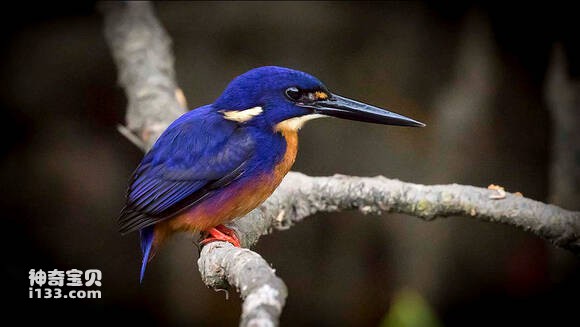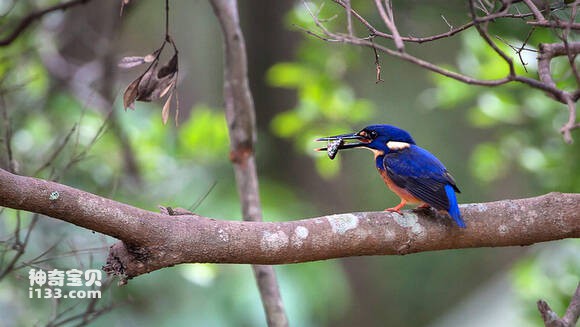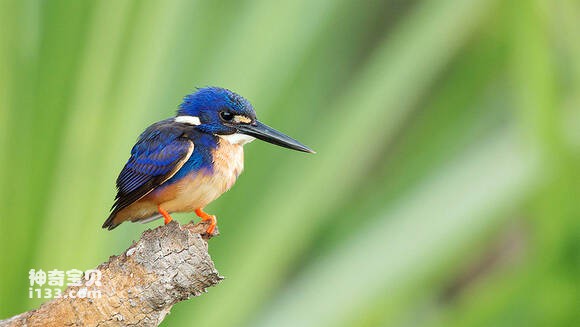Ceyx azureus
IUCN
LCBasic Information
Scientific classification
- name:Ceyx azureus
- Scientific Name:Ceyx azureus,Azure Kingfisher
- Outline:Climbing birds
- Family:
Vital signs
- length:17-19cm
- Weight:About 40g
- lifetime:No textual research information is available
Feature
It is mainly composed of bright blue and orange red feathers
Distribution and Habitat
The blue kingfisher is found in Australia, Indonesia and Papua New Guinea.
Blue kingfishers live in brush or open forest, clear and slow-flowing rivers, streams, lakes, streams, bays, mangroves, and even those near urban reservoirs.
Appearance
A small bird composed mainly of bright blue and orange red feathers, 17-19 cm in length, 25-29 cm in wingspan, and 40 g in weight. The body feathers are bright and brilliant, the head and back feathers are blue and glossy, the thorax and abdomen are beautiful bright orange or reddish brown, the wings have some black patches, the nape and throat have white spots, the lower tip of the tail is mottled gray-black, and the legs and feet are bright red.
Mouth thick straight, long and pointed, mouth ridge round; No nasal furrow; The wingtip is long, the first primary feathers are slightly shorter, and the third and fourth feathers are longest; Tail short round; The head is large, the neck is short, the wings are short and round, and the tail is mostly short; The mouth is long and pointed, the rostrum is round and blunt, the feet are very short, the toes are thin and weak, the fourth and third toes are mostly connected, and the second toe is only connected at the base. Caudal lipid gland qu
Details
Azure Kingfisher, Ceyx azureus, has seven subspecies.

Blue kingfishers often live alone, usually on the branches or rocks near the water, and sometimes on the low branches of small trees near the river. Often for a long time motionless staring at the water, as soon as the fish and shrimp in the water, immediately with a very rapid and fierce posture into the water with the mouth to catch. Sometimes the wings are suspended in the air, looking down at the water, and the food immediately plunges into the water and is quickly captured. The prey is usually brought back to the habitat, beaten on a tree branch or stone, and eaten whole after the fish is dead. Sometimes they also fly in a straight line at a low altitude over the water, flying very fast, often screaming while flying.

The blue kingfisher feeds mainly on small fish, eats crustaceans and a variety of aquatic insects and their larvae, and also pecks at small frogs and a few aquatic plants. When a kingfisher plunges into the water, it can also maintain excellent vision because its eyes can quickly adjust the contrast in the Angle of view caused by the light in the water. So the fishing ability is very strong。

The breeding season for blue kingfishers is between October and December, but generally lasts until January of the following year. The nest is preceded by a courtship flight, and the two parties continue to chase and dance along the winding streams and rivers. Blue kingfishers are monogamous. The nest is built in the dike of a river or stream, with a tunnel dug in the mouth for the nest, the cave is 80 centimeters to 1.30 meters deep, these caves are generally not added grass and feather bedding, but put some small cartilage and shell fragments as decoration, the eggs are directly laid on the nest ground. Each clutch lays 4-7 eggs. Eggs bluish-white, bright, slightly spotted, about 28 mm ×18 mm in size, 1-2 broods per year; The incubation period is about 21 days, and the eggs are incubated by both sexes, but the chicks are only fed by the female, and the chicks can live independently after 3-4 weeks of nursing.
Listed on the International Union for Conservation of Nature (IUCN) 2012 Red List of Threatened Species ver 3.1 - Low Risk (LC).
Protect wild animals and eliminate wild meat.
Maintaining ecological balance is everyone's responsibility!








